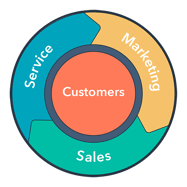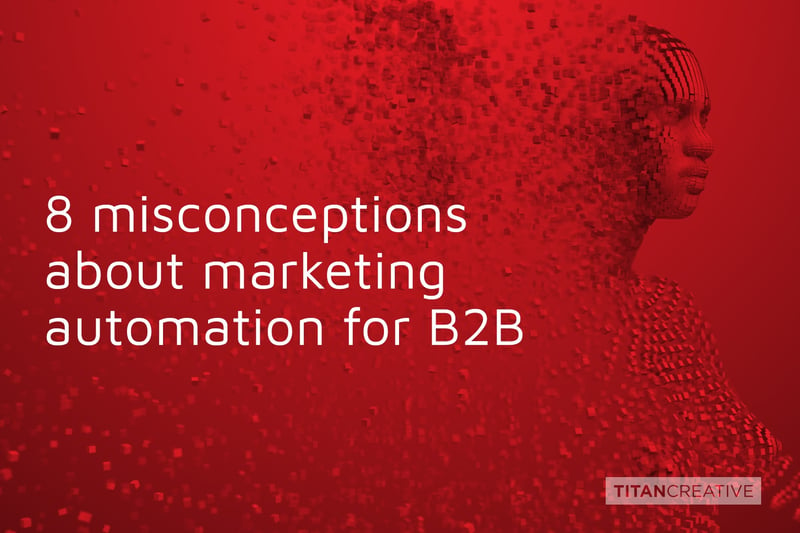When people think about marketing automation for B2B, a lot of assumptions are made that may – or may not be – founded. Get a clear-eyed view on what it all means with this 3-minute read...
Separate hype from value, and apprehension from possibility.
'Marketing automation' is a term that is bandied about quite frequently these days. Some of our B2B clients have embraced it, some are considering it, and some are trying to wrap their minds around what it actually means.
For many, the term evokes a nightmare scenario in which one is chased, forever, everywhere, by 'bots' who have acquired intel about you and will not stop until you are pushed into converting. This is not really what inbound marketing automation is about (the 'follow-me-everywhere' approach is actually a sometimes frustrating - and often creepy - type of retargeting).
Nevertheless, the word 'automation' in marketing lurks with ambiguous associations, along with fearful allusions to it's emerging, much more amorphous, hyped and controversial cousin, Artificial Intelligence.
A vast marketing wasteland of soulless exchanges seems to fill the horizon of the future.

Even those who understand the true nature and benefits of automation – and are less fearful – may worry about the complexity or cost of leveraging it in their marketing.
Let's look at some common misconceptions about marketing automation:
1. It's too complicated and cumbersome to plan, execute and manage.
It's understandable that it would seem daunting to leverage an automation component in marketing. "Who is going to build and support this? My teams are already maxed out..."
The truth is that good marketing automation actually relieves pressure on your team. Once you have configured it correctly, you can free up your human resources to focus on areas where they can drive the most value to your business.
With a good platform, you can continue to evolve and refine your automation to ensure that you are having touchpoints with your prospects that reflect their needs, their stage in the buying cycle, and tie them into sales alerts.
2. It's too expensive. It will require a huge investment in staff to support.
Under the hood, marketing automation is a lot less mysterious than it sounds. Either by working with an Agency Partner, or with an internal resource who can bridge strategy with optimized conversion flows, you can start leveraging automation out of the gate in simple ways, and develop it as you go.
If someone takes action to reach out to your company, they should be hearing back proactively. Automated messages from real employees show that the ball is moving forward and explain next steps in clear terms to the prospect.
We frequently set up automated 'Workflows' for clients that improve the prospect experience and trigger alerts for lead handling. Setting up this type of automation is not a huge project. And once it's set up, it just continues to run. It's a force multiplier.
Our clients have not needed to add resources to manage it. They simply need to make sure that their sales processes and people are aligned to proactively nurture leads. That's a good thing to be thinking about regardless of automation.
Platform costs vary – we use HubSpot and prefer it because it allows us to tie back to an integrated strategy with unified metrics.
3. It negates the use of people.
Quite the contrary, you need your people to run the strategy and focus on the back-end processes that are required to make the most of your overall marketing initiatives. Automation does not work in a silo, it's meant to ease the burden on people by automatically performing more repetitive tasks.
This frees them up to focus on areas where they can drive more value to your business.
4. It means invading people’s privacy or using aggressive tactics.
Marketing automation is not aggressive retargeting. It's simply a way to ensure that your prospects are having a good experience, and being carried forward toward your value prop based on their needs. Any good modern marketing strategy needs to be respectful of the customer, putting them at the center. The old outbound way of 'pushing' is not the ethos of Inbound, or the way marketing automation should be leveraged as part of an Inbound strategy.
Privacy-wise, there is no subterfuge. Prospects can and should be able to opt out of any kind of interaction at any point. But most won't if the experience being offered is helping them solve a problem or address a need.
5. It's not ‘strategic’ because it’s automated.
Another way of putting this, is that it's 'not strategic because it involves tracking results/data', which must infer a 'dumbing down' of the creative and strategic process happening behind it – right?
In fact, quite the inverse is true. To leverage marketing automation as part of an end-to-end Inbound marketing plan requires getting into the weeds on target persona dev, understanding on a deeper level what a prospect needs to see at any point in the buyer journey to come towards your solution in a more frictionless way, and creating content that will resonate. It's about aligning marketing with a measurable business result (closed loop attribution), and having granular metrics.
Doing this well requires an intricate strategy that goes well beyond traditional marketing. We've done both kinds of marketing. You can still ideate that clever headline/hook/idea for your billboard, and this can be great for an oblique sense of 'general brand awareness'. However, you can use that hook as part of a much wider digital strategy that's actually trackable, and based on results that can tie back to ROI and closed-loop reporting on new business. When you start to personalize the content experience, the impact can be even larger.
6. It's just another ‘marketing thing’ and does not really enable sales.
A certain amount of cynicism is to be expected and often warranted, in a marketing world filled with endless hype, a parade of thought-leaders, changing search algorithms, new buzzwords.
The fact is, that businesses are seeing tangible results around leveraging automation. The reason why I think it is becoming the new normal - and has moved way past 'fad' - is because of it's measurable impact on the sales process.

When a sales-person can know that a lead is being nurtured the right way, off the top, receive alerts on their behaviour, and reach out personally at exactly the right moment... it's entirely about actionable value.
When we step back, we can see how a great marketing experience, followed by a great sales experience, followed by a great service experience – with the customer at the center at every stage – can create an ecosystem that has a higher likelihood of success and growth vs. one that is fragmented or not aligned. (Read more about that here.)
7. It's a threat to traditional ways of thinking about and spending on marketing and brand.
To some degree this is true. It's forcing companies to ask harder questions about marketing budgets like:
"What is the actual return on our marketing spend?"
Agencies can't really hide behind the traditional red-carpet creative thinking and tactics. You spent $1 million on your out-of-home campaign. You invested in TV and print ads. Everyone thought it was clever and the agency might have even won an award. This is great. But can you track in tangible terms what it accomplished for your business? Is the Agency aligned with your actual bottom-line goals?
The truth is that red-carpet creative thinking is still crucial. But it's being held to a higher standard – and that's a good thing.
8. I have a feeling that many of our competitors are going down this road.
They are. And chances are, you should be too.
Once you do, you'll likely never look back.
Up next | Read our B2B Inbound marketing overview.
Titan One is a creative and digital Agency helping clients across North America drive results.

Learn about our fully-managed, ongoing strategic content packages for your business.


